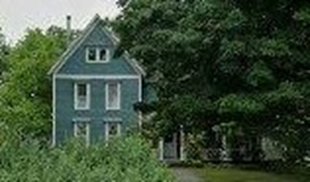
Pratt-Campbell Home
82 JOHN STREET
The Pratt-Campbell home at 82 John Street is listed by the town as being built in 1850 but first appears on an 1855 map of Akron as being owned by William Pratt. Mr. Pratt was a Village Trustee from 1858-1859 and “President” (Mayor) of the “Corporation”, as Akron was known then, from 1859-1860.
The home is purported to have been built by Jonathan Russell, Akron’s founder and sits on 1.1 acres of land which Mr. Russell purchased in 1828 for $506.
In 1854 Mr. Pratt purchased it for $5400. Originally the frame home ran north and south but by 1866 an east-west addition was added. At one time along the back border of the property was once a carriage house with a basement. From there down the driveway was a path for the horses to be walked.
The home is set back from the street and hosts many original trees of the property. There is an extensive front porch. Several renovations have been done, including changing the home back from a two-family dwelling to a one family dwelling.
Despite this one of the windows in the living room still retains its original glass. The attic windows have panes of colored glass with small cedar shake awnings over them and the house is trimmed in several places with fish scale wood trim. There still exists outside a slate sidewalk to the neighbors house.
It is said it was the third and final house Jonathan Russell lived in before moving west. In 1893 Elizabeth Edson Rich purchased the property. She was married to Charles Milton Rich, the son of the first owner of the Octagon House. Charles M. was a freight agent for the N.Y. Central Railroad. Mrs. Rich was a music teacher. The home at one time had a music conservatory among its 12 rooms.
Mrs. Rich was Elizabeth Edson Rich-two of her brothers served in the Civil War-each dying at the age of 20, in 1862 and 1864 respectively. She and her brothers are buried in Evergreen Lawn Cemetery.
From 1939-1955 the house was owned by Harry D. Martin and his wife Irma. The Martin grandchildren are said to have put on plays in the attic, hanging curtains over the windows and using the east -west portion as their stage in scenes reminiscent of something from “Little Women”.
